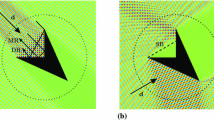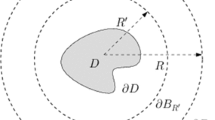Abstract
In this paper a time-dependent three-dimensional electromagnetic scattering problem is considered. Let R 3 be the three-dimensional real Euclidean space filled with a medium of electric permittivity ε, magnetic permeability μ and zero electric conductivity. The quantities ε, μ are positive constants and there are no free charges in the space and the free current is taken to be zero. Let Ω⊂R 3 be a bounded simply connected obstacle with a locally Lipschitz boundary ∂Ω, that is assumed to have a nonnegative constant boundary electromagnetic impedance. The limit cases of perfectly conducting and perfectly insulating obstacles are studied. An incoming electromagnetic wave packet that hits Ω is considered, and a method that solves the Maxwell equations to compute the corresponding electromagnetic field scattered by Ω as a superposition of time harmonic electromagnetic waves is proposed. These time-harmonic electromagnetic waves are the solutions of exterior boundary-value problems for the vector Helmholtz equation with the divergence-free condition and they are computed with an `operator expansion' method that generalizes the method presented by L. Fatone et al.[J. Math. Phys. 40 (1999) 4859–4887]. The method proposed here is computationally very efficient. In fact, it is highly parallelizable with respect to time and space variables. Several numerical experiments obtained with a parallel implementation of the method are shown. The numerical results obtained are discussed from a numerical and a physical point of view. The quantitative character of the numerical experiments shown is established. The website: http://www.econ.unian.it/recchioni/w4/ contains some animations relative to the numerical experiments.
Similar content being viewed by others
References
C.D. Munz and P. Ommes, A three-dimensional finite-volume solver for the Maxwell equations with divergence cleaning on unstructured meshes. Comp. Phys. Comm. 130 (2000) 83–117.
F. Assous, P. Degond, E. Heintze, P. Raviart and J. Segrè, On a finite-element method for solving the threedimensional Maxwell equations. J. Comp. Phys. 109 (1993) 222–237.
A. Taflove and S.C. Hagness, Computational Electrodynamics: The Finite-Difference Time Domain Method 2nd Edition. Boston: Artech House (2000) 878 pp.
J.F. Lee, R. Lee and A. Cangellaris, Time-domain finite elements methods. IEEE Trans. Antennas Propag. 45 (1997) 430–442.
N.K. Madsen and R.W. Ziolkowski, A three-dimensional modified finite volume technique for Maxwell's equations. Electromagnetics 10 (1990) 147–161.
F. Edelvik and G. Ledfelt, Explicit hybrid time domain solver for the Maxwell equations in 3D. J. Scient. Comp. 15 (2000) 61–78.
J.M. Song and W.C. Chew, Multilevel fast-multipole algorithm for solving combined field integral equations of electromagnetic scattering. Microwave Opt. Tech. Lett. 10 (1995) 14–19.
A.A. Ergin, B. Shanker and E. Michielssen, Fast evaluation of three-dimensional transient wave field using diagonal translation operators. J. Comp. Phys. 146 (1998) 157–180.
K.S. Yee, Numerical solution of initial boundary value problems involving Maxwell's equations in isotropic media. IEEE Trans. Antennas Propagation 14 (1966) 302–307.
F.L. Teixeira and W.C. Chew, Lattice electromagnetic theory from a topological viewpoint. J. Math. Phys. 40 (1999) 169–187.
C.D. Munz, R. Schneider, E. Sonnendrücker and U. Voss, Maxwell's equations when the charge conservation is not satisfied. Compt. Rendus Académie des Sci. Paris 328 (1999) 431–436.
K.L. Shlager, J.G. Maloney, S.L. Ray and A.F. Peterson, Relative accuracy of several finite-difference timedomain methods in two and three dimensions. IEEE Trans. Antennas Propagation 41 (1993) 1732–1737.
G. Mur, Absorbing boundary conditions for the finite-difference approximation of the time-domain electromagnetic-field equations. IEEE Trans. Electromagn. Compatibility 23 (1982) 377–382.
Y. Lu and C.Y. Shen, A domain decomposition finite-difference method for parallel numerical implementation of time-dependent Maxwell's equations. IEEE Trans. Antennas Propagation 45 (1997) 556–562.
F. Assous, P. Degond and J. Segrè, Numerical approximation of the Maxwell equations in inhomogeneous media by a P 1 conforming finite element method. J. Comp. Phys. 126 (1996) 363–380.
B. Jiang, J. Wu and L.A. Povinelli, The origin of spurious solutions in computational electromagnetics. J. Comp. Phys. 125 (1996) 104–123.
G. Manara, A. Monorchio and R. Reggiannini, A space-time discretization criterion for a stable timemarching solution of the electric field integral equation. IEEE Trans. Antennas Propagation 45 (1997) 527–532.
R. Coifman, V. Rokhlin and S. Wandzura, The fast multipole method for wave equation: a pedestrian prescription. IEEE Antennas Propag. Mag. 35 (1993) 7–12.
L. Fatone, C. Pignotti, M.C. Recchioni and F. Zirilli, Time harmonic electromagnetic scattering from a bounded obstacle: An existence theorem and a computational method. J. Math. Phys. 40 (1999) 4859–4887.
E. Heyman, Time-dependent plane-wave spectrum representations for radiation from volume source distributions. J. Math. Phys. 37 (1996) 658–681.
E. Mecocci, L. Misici, M.C. Recchioni and F. Zirilli, A new formalism for time dependent wave scattering from a bounded obstacle. J. Acoust. Soc. Amer. 107 (2000) 1825–1840.
D.M. Milder, An improved formalism for wave scattering from rough surface. J. Acoust. Soc. Amer. 89 (1991) 529–541.
D.M. Milder, Role of the admittance operator in rough-surface scattering. J. Acoust. Soc. Amer. 100 (1996) 759–768.
D.M. Milder, An improved formulation of coherent forward scatterer from random rough surfaces. Waves Rand. Med. 8 (1998) 67–78.
L. Misici, G. Pacelli and F. Zirilli, A new formalism for wave scattering from a bounded obstacle. J. Acoust. Soc. Amer. 103 (1998) 106–113.
F. Mariani, M.C. Recchioni and F. Zirilli, The use of the Pontryagin maximum principle in a furtivity problem in time dependent acoustic obstacle scattering. Waves Rand. Med. 11 (2001) 549–575.
F. Mariani, M.C. Recchioni and F. Zirilli, A perturbative approach to acoustic scattering from a vibrating bounded obstacle. J. Comp. Acoust. 10 (2002) 349–384.
M.C. Recchioni and F. Zirilli, The use of wavelets in the operator expansion method for time dependent acoustic obstacle scattering. Submitted to Siam J. Scient. Comp.
D.M. Milder, An improved formalism for electromagnetic scattering from a perfectly conducting rough surface. Radio Sci. 31 (1996) 1369–1376.
S. Piccolo, M.C. Recchioni and F. Zirilli, The time harmonic electromagnetic field in a disturbed half-space: An existence theorem and a computational method. J. Math. Phys. 37 (1996) 2762–2786.
R.A. Smith, The operator expansion formalism for electromagnetic scattering from rough dielectric surfaces. Radio Sci. 31 (1996) 1377–1385.
R. Coifman, A. McIntosh and Y. Meyer, L'intégrale de Cauchy définit un opérateur borné sur L 2 pour les courbes lipschitziennes. Annals Math. 116 (1982) 361–387.
G. Verchota, Layer potentials and boundary value problems for Laplace's equation in Lipschitz domains. J. Funct. Anal. 59 (1984) 572–611.
J. Nečas, Les Méthodes Directes en Théorie des Équations Elliptiques. Paris: Masson & Cie. Publ. (1967) 351 pp.
J.A. Stratton, Electromagnetic Theory. New York: McGraw-Hill Book Company (1941) 615 pp.
T.S. Angell and A. Kirsch, The conductive boundary condition for Maxwell's equations. SIAMJ. Appl. Math. 52 (1992) 1597–1610.
A. Ghizzetti and A. Ossicini, Quadrature Formulae. Basel: Birkhäuser Verlag (1970) 191 pp.
M. Abramowitz and I.A. Stegun, Handbook of Mathematical Functions. New York: Dover (1970) 1046 pp.
P.M. Morse and H. Feshbach, Methods of Theoretical Physics Vol II. New York: Mc Graw Hill (1953) 1978 pp.
Author information
Authors and Affiliations
Rights and permissions
About this article
Cite this article
Recchioni, M.C., Zirilli, F. A new formalism for time-dependent electromagnetic scattering from a bounded obstacle. Journal of Engineering Mathematics 47, 17–43 (2003). https://doi.org/10.1023/A:1025570924371
Issue Date:
DOI: https://doi.org/10.1023/A:1025570924371




